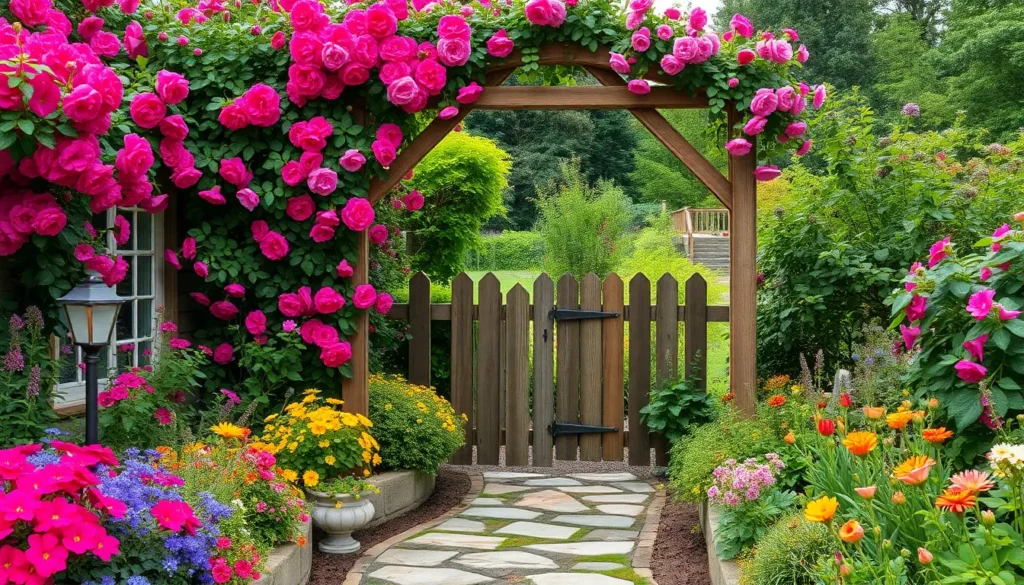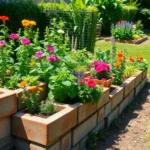We’ve all dreamed of stepping into a storybook garden where wildflowers dance alongside vegetables and charming pathways wind through organized chaos. Cottage gardens represent the perfect blend of beauty and functionality – a timeless gardening style that’s captured hearts for centuries.
These enchanting spaces aren’t just about pretty flowers. They’re about creating sustainable ecosystems where herbs mingle with roses and practical meets whimsical. We’re talking about gardens that feed both your family and your soul while requiring less maintenance than you’d expect.
Whether you’re working with a sprawling backyard or a cozy urban plot, cottage garden design adapts beautifully to any space. We’ll show you how to transform your outdoor area into a romantic retreat that looks effortlessly wild yet purposefully planned. From choosing the right plants to creating those quintessential winding paths, you’ll discover why this beloved gardening style continues to inspire green thumbs everywhere.
Create a Charming Entrance With Traditional Cottage Garden Gates
Gates serve as the perfect introduction to your cottage garden sanctuary, setting the tone for the enchanting experience that awaits beyond. We’ll explore three essential elements that transform ordinary entrances into captivating cottage garden portals.
Wooden Picket Fence Gates
White picket gates remain the quintessential cottage garden entrance, offering timeless charm that complements both traditional and modern home styles. We recommend cedar or pressure-treated pine for durability, as these materials withstand weather conditions while maintaining their rustic appeal for decades. Height typically ranges from 36 to 48 inches, creating an inviting barrier that defines your garden space without blocking views of your beautiful plantings.
Spacing between pickets should measure 3 to 4 inches apart, allowing glimpses of colorful blooms like hollyhocks, delphiniums, and climbing roses that frame the entrance. Paint finishes in classic white, soft cream, or weathered gray enhance the cottage aesthetic while providing protection against moisture and UV damage. Self-closing hinges ensure your gate remains functional while maintaining the carefree cottage garden atmosphere.
Arbor and Trellis Combinations
Overhead structures create dramatic entrances that showcase climbing plants like clematis, honeysuckle, and rambling roses in spectacular fashion. We suggest combining a simple wooden gate with an arched arbor measuring 7 to 8 feet in height, providing adequate clearance for visitors while supporting vigorous climbing varieties. Materials like cedar, redwood, or vinyl offer longevity with minimal maintenance requirements.
Trellis panels on either side of the gate extend the vertical growing space, accommodating sweet peas, morning glories, and jasmine that create living walls of fragrance and color. Wire or string supports between arbor posts guide climbing plants upward, ensuring even coverage across the entire structure. This combination transforms your entrance into a natural tunnel that provides shade and creates anticipation for the garden treasures beyond.
Vintage Hardware and Latches
Authentic hardware details distinguish cottage garden gates from standard fencing, adding character that reflects the garden’s handcrafted heritage. We prefer thumb latches, slide bolts, and strap hinges in black iron or antique brass finishes that develop beautiful patina over time. These traditional mechanisms operate smoothly while contributing to the overall cottage aesthetic.
Decorative elements like wrought iron scrollwork, hand-forged handles, and period-appropriate hinges create focal points that draw attention to your garden entrance. Antique shops, salvage yards, and specialty hardware suppliers offer authentic pieces that bring genuine vintage charm to modern installations. Surface-mounted hardware works best on cottage gates, as it showcases the craftsmanship while ensuring easy maintenance and adjustment over the years.
Plant Mixed Flower Borders for Abundant Color
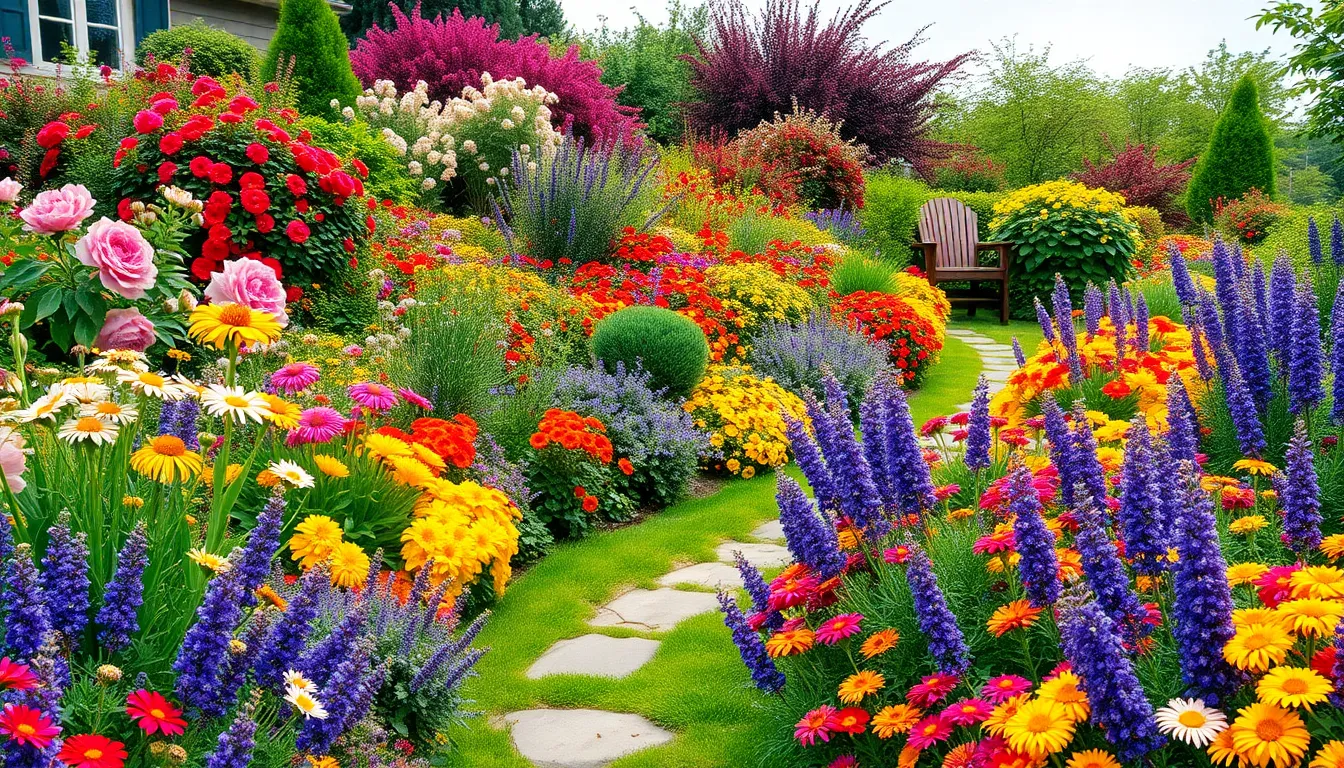
Mixed flower borders create the quintessential cottage garden look we all admire. These vibrant displays combine different plant types to ensure continuous blooms throughout the growing season.
Combine Perennials and Annuals
Perennials provide the structural backbone that returns year after year, offering reliable beauty and stability to our cottage garden borders. Roses, peonies, and coneflowers establish permanent focal points that mature and become more impressive over time. Annuals like marigolds and zinnias fill gaps quickly and deliver instant bursts of seasonal color that keep our gardens looking fresh.
Mixing these plant types creates a ever-changing industry that evolves throughout the seasons. We get the best of both worlds: the dependable framework of perennials and the flexibility to experiment with new annual varieties each year. This combination ensures our borders never look static or predictable.
Layer Heights for Visual Interest
Layering different plant heights transforms flat garden spaces into captivating three dimensional displays. Taller shrubs and small trees form the backdrop, creating vertical structure that draws the eye upward. Mid level perennials fill the middle ground with substantial mass and seasonal interest.
Shorter flowering plants cascade along the front edges, softening hard lines and creating gentle transitions. This tiered approach mimics natural plant communities and ensures every plant receives appropriate light exposure. Strategic height placement also prevents taller specimens from overshadowing smaller treasures.
Choose Fragrant Blooms
Fragrant flowers like roses, lavender, and honeysuckle transform our cottage gardens into sensory experiences that engage more than just our visual senses. These aromatic blooms create invisible pathways of scent that guide visitors through different garden areas. Sweet fragrances also attract beneficial pollinators like bees and butterflies, supporting the garden’s network.
Evening blooming plants such as night scented stock and four o’clocks release their perfume after sunset, extending our garden enjoyment into twilight hours. Positioning fragrant plants near seating areas, pathways, and windows maximizes our ability to appreciate their natural aromatherapy throughout the day.
Incorporate Climbing Plants and Vertical Elements
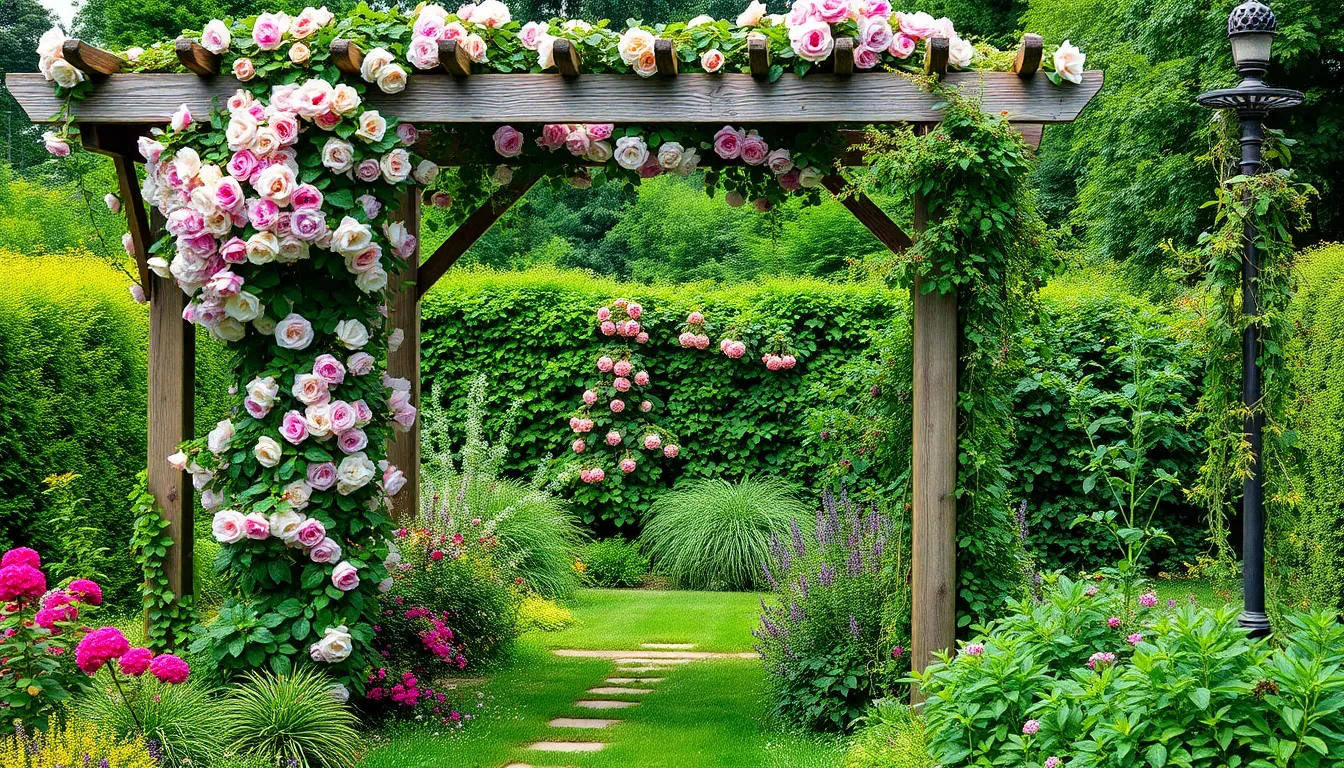
Vertical structures transform cottage gardens by adding height, depth, and the layered displays that define this beloved garden style. These elements support climbing plants while creating dramatic focal points throughout your outdoor space.
Rose-Covered Arbors and Pergolas
Rose-covered arbors serve as the quintessential hallmark of cottage garden design, creating romantic entryways that capture old-industry charm. English climbing roses excel in this application due to their continuous flowering habit and abundant blooms that cascade over wooden structures. We recommend training these roses over pergolas to establish dramatic overhead canopies filled with lush foliage and fragrant flowers.
Pergola installations provide substantial support for vigorous climbing rose varieties while creating defined pathways through your garden spaces. Arbor structures work particularly well at garden entrances or transition points between different garden rooms. Consider positioning these features where morning sun reaches the roses while afternoon shade protects the blooms from intense heat.
Clematis and Honeysuckle Vines
Clematis earns its title as the “Queen of Climbers” through vigorous growth patterns and self-clinging tendrils that easily attach to vertical supports. Large, showy flowers appear in various colors from deep purples to pristine whites, creating stunning displays against trellises and arbors. These climbing plants thrive when their roots remain shaded while their tops reach full sun to partial shade conditions.
Honeysuckle vines pair beautifully with clematis plantings, offering complementary growth habits and pleasant scents that attract beneficial pollinators. Both species contribute to the cottage garden’s signature abundance while requiring minimal maintenance once established. We suggest planting these vines near seating areas where you’ll appreciate their fragrant blooms during evening garden visits.
Bean Poles and Obelisks
Bean poles introduce functional vertical elements that support both edible crops and ornamental climbing plants in traditional cottage garden style. Sweet peas flourish on wigwam-style supports, producing fragrant, colorful blooms that enhance the garden’s sensory appeal. These structures blend seamlessly with the informal cottage aesthetic while providing practical growing answers.
Obelisk installations create elegant vertical lines using natural materials like wood or bamboo that complement the garden’s organic feel. Black-eyed Susan vines (Thunbergia) climb these supports beautifully, displaying unique red, apricot, or buff flowers with distinctive dark centers. Tuteur structures serve similar purposes with their pyramidal shapes adding architectural interest to planting beds while supporting climbing vegetables and flowering vines.
Design Winding Pathways Through Your Garden

Meandering pathways create the backbone of authentic cottage garden design. We’ll explore three distinct approaches that transform ordinary walkways into charming garden features.
Gravel and Stone Walkways
Gravel walkways offer exceptional durability while maintaining the rustic charm essential to cottage gardens. We recommend crushed gravel as an eco-friendly option that allows water to percolate naturally into the soil, reducing harmful runoff throughout your garden space.
Stone pavers create elegant pathways that withstand heavy foot traffic and seasonal weather changes. Brick materials provide another classic option, delivering timeless appeal that complements traditional cottage garden aesthetics. These hardscaping materials require minimal maintenance while offering long-term beauty.
Combining different textures enhances visual interest along your garden paths. We suggest alternating gravel sections with stone pavers to create rhythm and movement throughout the walkway design.
Stepping Stone Patterns
Stepping stones transform functional pathways into artistic garden features that guide visitors through your cottage industry. We place these individual stones along winding routes to create visually appealing patterns that add character to any garden design.
Strategic placement allows stepping stones to function as standalone decorative elements beyond their practical purpose. Consider spacing stones 18-24 inches apart for comfortable walking while maintaining the informal cottage garden aesthetic.
Natural stone varieties like flagstone or slate complement the organic cottage garden style perfectly. We often incorporate irregularly shaped stones to enhance the natural, unstructured appearance that defines authentic cottage gardens.
Herb-Lined Path Edges
Thyme creates fragrant borders that release delightful scents when brushed against during garden walks. We plant low-growing thyme varieties along pathway edges to provide both practical beauty and aromatic pleasure throughout the growing season.
Rosemary offers evergreen structure while delivering culinary benefits for cottage garden enthusiasts. This hardy herb maintains its appearance year-round, providing consistent visual appeal along walkway borders.
Lavender borders add elegance and attract beneficial pollinators to your cottage garden network. We recommend planting lavender varieties 12-18 inches from path edges to prevent overgrowth while maximizing their fragrant impact on garden visitors.
Add Vintage Garden Structures and Focal Points
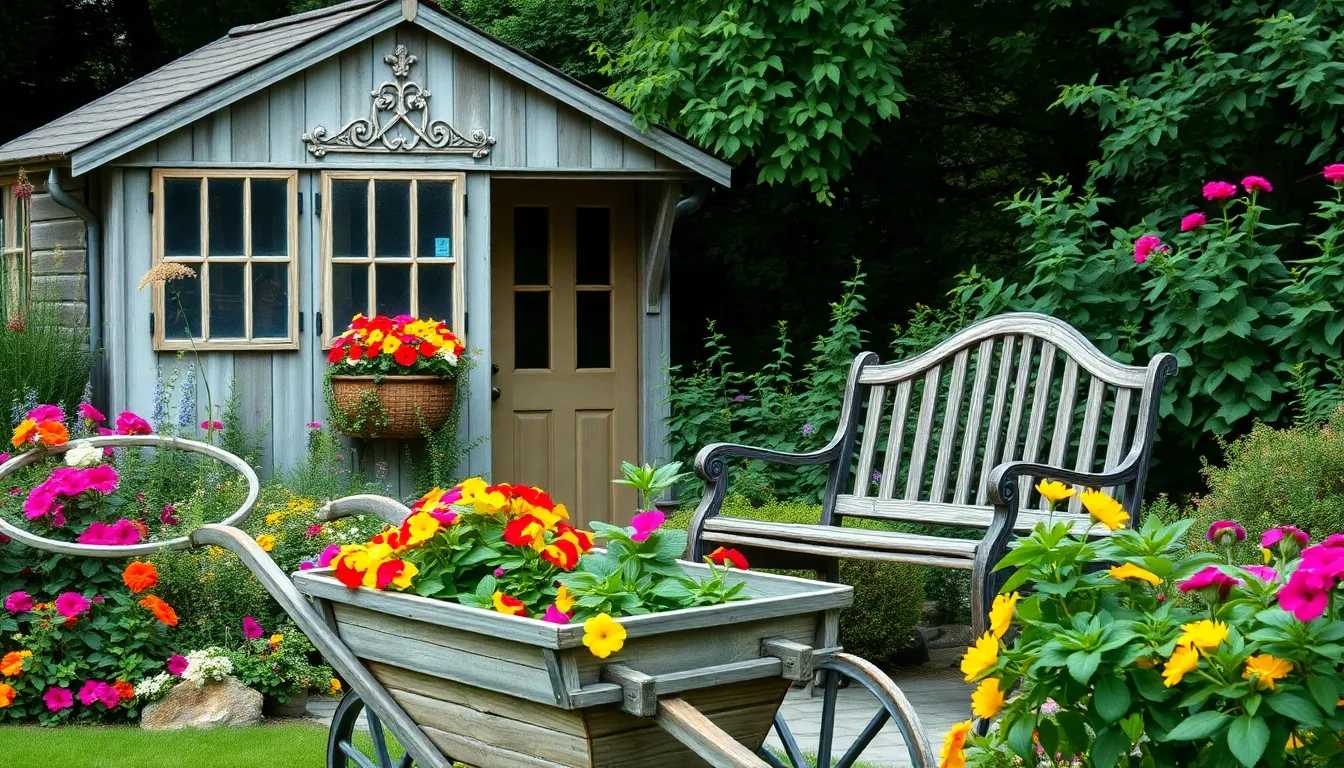
Transforming ordinary spaces into charming cottage gardens requires carefully chosen structures that serve both functional and aesthetic purposes. These timeless elements create visual anchors that define the romantic, lived-in character every cottage garden needs.
Weathered Garden Sheds
Weathered garden sheds add authentic rustic charm while providing essential storage space for your cottage garden needs. We recommend selecting sheds with naturally aged wood or distressed paint finishes that complement your garden’s established palette. Position your shed strategically to serve as a quiet retreat where you can pot plants or simply enjoy peaceful moments surrounded by lush vegetation.
Consider sheds with traditional features like diamond-pane windows, cedar shingle roofing, or vintage-style hardware that reinforces the cottage aesthetic. Storage functionality becomes secondary to the visual impact these structures create as focal points throughout your garden space. Weathering naturally occurs over time, but you can accelerate this process using specialized paint techniques or by selecting reclaimed materials that already possess that coveted aged appearance.
Antique Wheelbarrows and Planters
Antique wheelbarrows transform into stunning decorative planters that instantly add vintage appeal to any cottage garden setting. We’ve found that weathered wooden wheelbarrows work exceptionally well for displaying cascading flowers like petunias or trailing nasturtiums. Position these repurposed pieces near pathways or garden entrances where they’ll catch visitors’ attention while serving as functional growing containers.
Vintage metal planters, including old watering cans and galvanized buckets, create additional layers of cottage charm throughout your space. Search antique stores or estate sales for authentic pieces that show natural patina and character marks from years of use. Plant these containers with herbs like thyme or rosemary to combine practical growing space with decorative elements that enhance your garden’s overall cottage appeal.
Rustic Garden Benches
Rustic garden benches provide cozy seating areas strategically placed amidst lush vegetation where you can fully appreciate your cottage garden’s beauty. We prefer weathered wood benches with simple construction that reflects traditional craftsmanship over modern manufactured pieces. Teak, cedar, or reclaimed barn wood options develop beautiful patina naturally while withstanding outdoor conditions throughout multiple seasons.
Placement becomes crucial for maximizing both comfort and visual impact within your cottage garden design. Position benches along curved pathways where they invite rest and contemplation while framing views of your most spectacular plant combinations. Stone or wrought iron benches offer alternative materials that complement cottage aesthetics while providing durable seating that requires minimal maintenance over time.
Create Productive Kitchen Garden Spaces

Cottage gardens thrive when we blend beauty with functionality, creating spaces that nourish both our families and the soul. These productive kitchen garden elements transform traditional ornamental displays into abundant harvesting opportunities.
Raised Vegetable Beds
Raised vegetable beds form the backbone of productive cottage garden spaces, offering superior drainage and soil structure for optimal plant growth. We recommend building beds 8-12 inches high using cedar or composite materials that complement the garden’s rustic aesthetic. These elevated growing areas warm up faster in spring and provide better control over soil composition, allowing us to customize growing conditions for different vegetables.
Positioning raised beds strategically throughout the garden creates organized growing zones while maintaining the informal cottage garden charm. We can incorporate a variety of vegetables like heirloom tomatoes, leafy greens, and root vegetables that thrive in the improved drainage these structures provide. The defined edges of raised beds also make maintenance tasks like weeding and harvesting significantly easier than traditional ground level planting.
Herb Spiral Gardens
Herb spiral gardens maximize growing space while creating stunning focal points that enhance both form and function in cottage garden designs. We build these spirals using natural stone or reclaimed brick, creating multiple microclimates within a compact 6-8 foot diameter space. The elevated design allows sun loving herbs like rosemary and thyme to occupy the sunny top positions while moisture loving plants like parsley and chives thrive in the shadier, lower sections.
Spiral gardens offer year round visual interest through varied textures, heights, and seasonal changes in the herb plantings. We can harvest fresh ingredients steps away from our kitchen door while enjoying the fragrant aromatics these herbs release when brushed against during garden walks. The vertical growing approach typical of spiral designs makes efficient use of small spaces, perfect for cottage gardens where every square foot counts.
Companion Planting Techniques
Companion planting techniques create natural pest management systems while maximizing productivity in cottage garden kitchen spaces. We pair marigolds with tomatoes to deter harmful insects while attracting beneficial pollinators that improve overall garden health. These strategic plant partnerships reduce the need for chemical interventions and create more resilient growing ecosystems.
Implementing crop rotation schedules maintains soil fertility and prevents pest buildup that can devastate single crop plantings. We rotate plant families through different bed sections each season, allowing nitrogen fixing legumes to enrich soil for heavy feeding vegetables like cabbage and corn. Smart companion combinations like planting basil near peppers or nasturtiums throughout vegetable beds create living mulches that suppress weeds while providing additional harvest opportunities for both culinary and ornamental purposes.
Establish Natural Wildlife Habitats
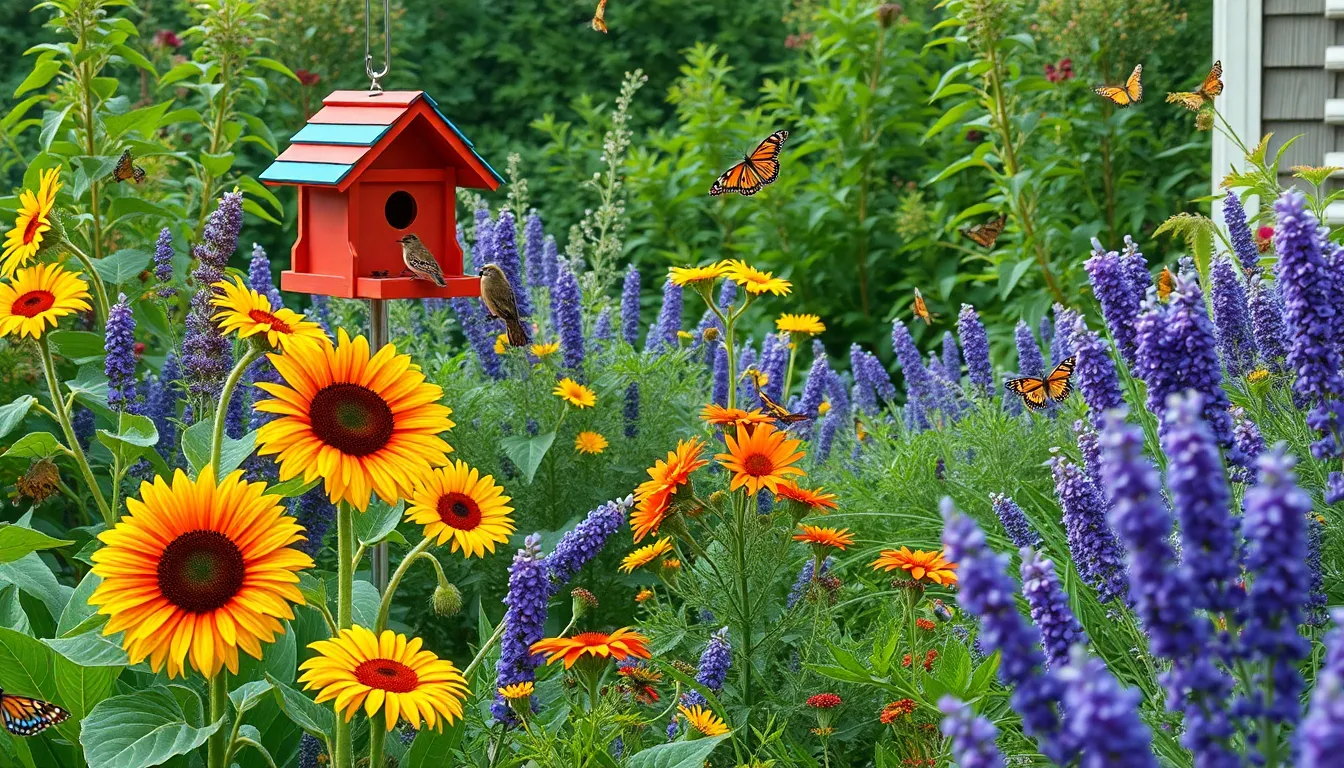
Wildlife habitats form the heart of successful cottage gardens, creating thriving ecosystems that support local fauna while maintaining the romantic charm we love. Layered planting approaches that incorporate ground covers, herbaceous plants, shrubs, and trees mimic natural ecosystems and provide diverse habitats for wildlife.
Native Plant Selections
Native plant selections create the foundation for sustainable cottage garden ecosystems that require minimal maintenance while supporting local wildlife. Regional plants naturally provide essential food and shelter for local fauna, reducing our need for chemical inputs and excessive water consumption.
Indigenous species adapt better to local climate conditions, making them more resilient during seasonal changes and weather extremes. Wildlife recognizes these familiar plants as reliable food sources, encouraging birds, beneficial insects, and small mammals to make our gardens their permanent homes.
Choosing native varieties also means we’re supporting the natural food web that existed in our area before development. Local nurseries often stock region-exact plants that complement traditional cottage garden aesthetics while serving ecological purposes.
Bird Houses and Feeding Stations
Bird houses provide essential nesting sites that enhance garden biodiversity while adding charming focal points throughout our industry. Strategic placement of different sized houses attracts various bird species, from tiny wrens to larger songbirds.
Feeding stations create year-round wildlife activity that brings movement and sound to our cottage gardens. Bird feeders filled with quality seeds attract diverse species, while bird baths provide crucial water sources for drinking and bathing.
Multiple feeding stations placed at different heights accommodate various bird feeding preferences and reduce competition. Ground-level feeders attract species like juncos and sparrows, while hanging feeders draw finches and chickadees to our gardens.
Water features near feeding areas create complete habitat zones that encourage birds to establish territories within our garden boundaries. Clean, fresh water sources become magnets for wildlife, especially during dry seasons when natural sources become scarce.
Pollinator-Friendly Flower Choices
Pollinator friendly flower choices transform cottage gardens into buzzing havens that support essential bee and butterfly populations. Flowers rich in nectar and pollen, such as sunflowers, zinnias, and lavender, attract beneficial pollinators while adding vibrant colors to our industry.
Continuous bloom schedules ensure food sources remain available throughout growing seasons, supporting pollinator life cycles from spring through fall. Early bloomers like crocuses provide crucial early season nutrition, while late-flowering asters sustain pollinators preparing for winter.
Native wildflowers mixed with traditional cottage garden favorites create diverse pollinator buffets that appeal to different species preferences. Single-flowered varieties often provide better access to nectar than double-flowered cultivars, making them more valuable for wildlife.
Clustering similar flowers together creates visual impact while making it easier for pollinators to locate and efficiently gather resources. Groups of three to five plants of the same species work more effectively than scattered individual plants throughout our garden design.
Use Reclaimed Materials for Authentic Character
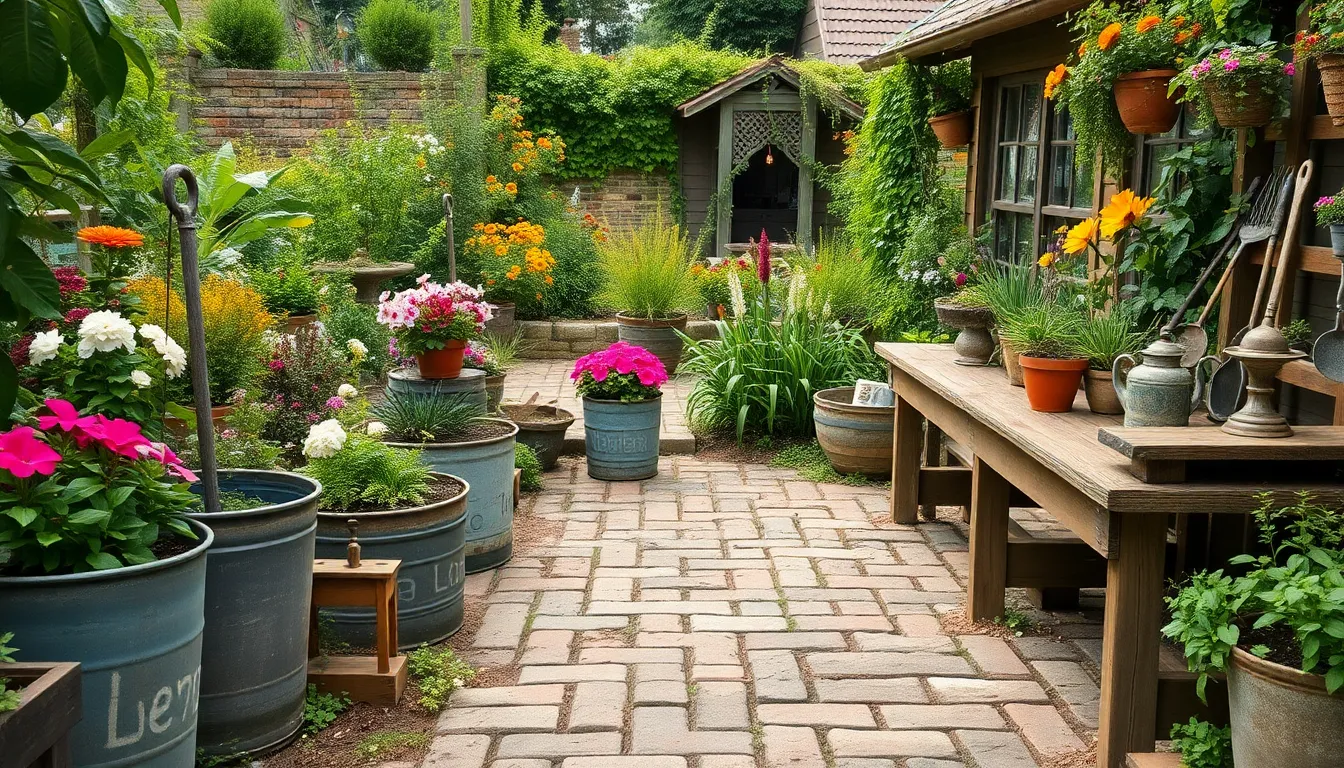
Reclaimed materials add genuine charm and sustainable value to cottage gardens while honoring traditional gardening practices.
Salvaged Brick and Stone
Recycled stone creates stunning hardscape features that complement the organic nature of cottage gardens. We recommend using salvaged stone for garden paths, charming patios, and rustic retaining walls that age beautifully over time.
Builder’s rubble transforms into functional garden elements through creative repurposing techniques. Old concrete pieces work excellently as mulch around larger plants, while broken stone creates dramatic rockery features that provide excellent drainage for alpine plants and succulents.
Weathered brick adds instant character to cottage garden designs with its warm, earthy tones. We’ve found that reclaimed brick works perfectly for edging flower beds, creating raised planters, and building low garden walls that develop attractive moss and patina over years.
Repurposed Garden Containers
Old containers become charming planters that capture the essence of cottage garden style. Vintage galvanized tubs, weathered wooden barrels, and antique ceramic pots create perfect homes for herbs, flowers, and cascading plants like trailing nasturtiums or ivy.
Unexpected items make delightful plant containers when we think creatively about repurposing household objects. Old wellington boots become whimsical planters for small herbs, while wooden crates stack beautifully to create tiered displays filled with colorful annuals and perennials.
Vintage sinks and washbasins create unique focal points in cottage gardens when converted to specialty planters. We suggest drilling drainage holes and filling these containers with drought tolerant plants like sedums, lavender, or Mediterranean herbs that thrive in shallow soil conditions.
Vintage Garden Tools as Decor
Decorative tool displays add nostalgic charm to cottage garden walls and fences throughout the growing season. We recommend hanging collections of vintage spades, rakes, and hoes on weathered wood surfaces to create attractive focal points that celebrate gardening heritage.
Garden statues and vintage fixtures enhance authenticity when sourced from estate sales, antique shops, and flea markets. Old birdbaths, decorative urns, and weathered garden sculptures provide perfect resting spots for wildlife while adding timeless elegance to planted areas.
Repurposed farming equipment creates stunning centerpieces in larger cottage garden spaces. Antique wheelbarrows filled with seasonal blooms, old milk churns planted with trailing flowers, and vintage watering cans displayed among herb borders all contribute to the lived in character that defines authentic cottage gardens.
Plan Seasonal Interest Throughout the Year
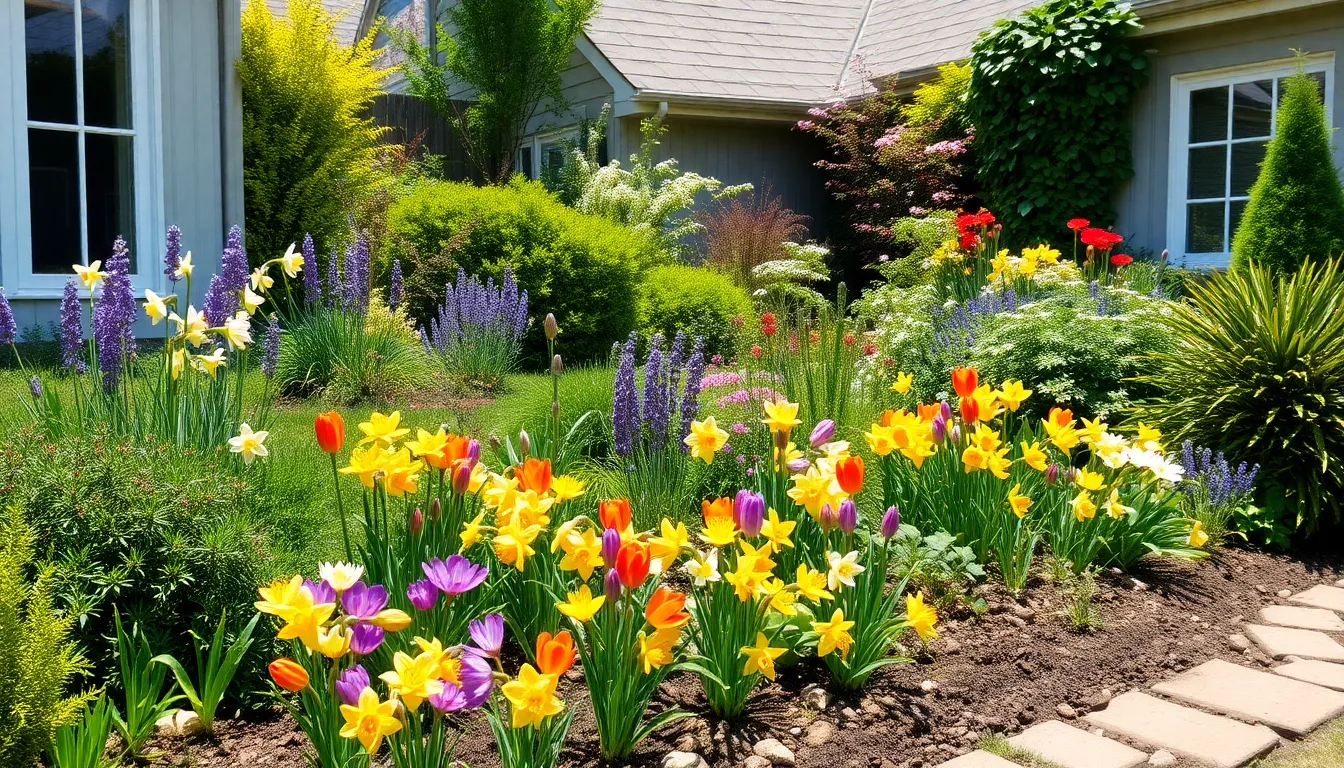
Creating year-round beauty in our cottage gardens requires thoughtful planning that ensures continuous visual appeal. We’ll explore strategic planting approaches that deliver stunning displays from spring’s first blooms through autumn’s final harvest.
Spring Bulb Displays
Early spring bulbs transform our cottage gardens into vibrant wonderlands when most perennials are still dormant. We recommend planting crocuses, daffodils, and tulips in naturalized drifts rather than formal rows to achieve that authentic cottage garden charm. Combining these bulbs with emerging perennials and established shrubs creates layered plantings that provide depth and visual interest.
Succession planting different bulb varieties extends the spring display from February through May. We suggest starting with early crocuses and snowdrops, followed by daffodils and hyacinths, then finishing with tulips and alliums. Interplanting bulbs beneath deciduous shrubs maximizes space while creating surprise pockets of color throughout the garden.
Summer Flowering Succession
Continuous bloom becomes our primary goal during summer months when cottage gardens reach their peak performance. We achieve this by planting successive waves of flowering plants that ensure overlapping blooms from early June through September. Combining quick growing annuals like marigolds and zinnias with reliable perennials such as roses and hydrangeas creates ever-changing displays.
Herb and vegetable integration amplifies both beauty and functionality during summer’s abundance. We weave fragrant basil, colorful chard, and climbing beans throughout flower borders to create that quintessential cottage garden mixture. Strategic deadheading and regular watering maintain peak flowering performance while encouraging extended bloom periods.
Autumn Foliage and Berries
Colorful foliage extends our cottage garden’s appeal well beyond summer’s final flowers. We incorporate plants with vibrant fall colors such as maple trees, asters, and ornamental grasses to create stunning autumn vignettes. These selections provide structure and visual weight as herbaceous perennials begin their natural decline.
Berry producing shrubs offer both wildlife value and decorative appeal during autumn months. We recommend adding viburnum and pyracantha for their brilliant berry displays that persist into winter. Strategic placement of these shrubs near pathways and seating areas ensures we can appreciate their seasonal beauty while providing essential food sources for garden birds.
Conclusion
Creating your dream cottage garden is an incredibly rewarding journey that transforms any outdoor space into a living masterpiece. We’ve shown you how these enchanting gardens seamlessly blend beauty with functionality while supporting local ecosystems and providing year-round enjoyment.
The magic lies in the thoughtful combination of elements we’ve explored – from charming entrances and winding pathways to productive kitchen spaces and wildlife habitats. Each component works together to create that quintessential cottage garden atmosphere that’s both romantic and practical.
Remember that cottage gardens evolve naturally over time becoming more beautiful with each passing season. Start with the elements that excite you most whether it’s fragrant herb borders or climbing rose arbors and gradually build your perfect cottage garden retreat.
Your cottage garden awaits – it’s time to turn these ideas into your own blooming sanctuary.
Frequently Asked Questions
What is a cottage garden?
A cottage garden is a charming, informal garden style that combines beauty and functionality. It blends herbs, flowers, and vegetables in a sustainable ecosystem that nourishes both families and the environment. These gardens feature mixed plantings, winding pathways, and vintage elements that create a romantic, lived-in aesthetic while providing practical benefits like food production and wildlife habitat.
Can I create a cottage garden in a small space?
Yes, cottage gardens can be designed for any space size. The key is maximizing vertical growing with climbing plants, arbors, and trellises. Use raised beds for vegetables, herb spirals for compact growing, and layered planting with varying heights. Even small spaces can incorporate the essential cottage garden elements like mixed borders, fragrant plants, and charming pathways.
What are the best plants for cottage garden borders?
Combine perennials for structural beauty with annuals for seasonal color. Include fragrant blooms like roses and lavender to enhance sensory experience and attract pollinators. Layer plants by height with taller specimens as backdrops and shorter ones softening edges. Choose plants that provide continuous blooms throughout the seasons for dynamic, evolving displays.
How do I create an attractive cottage garden entrance?
Focus on three key elements: wooden picket fence gates made from durable materials like cedar, arbors or trellises adorned with climbing plants for dramatic effect, and vintage hardware with authentic latches for character. These components transform ordinary entrances into enchanting portals that set the tone for your cottage garden experience.
What climbing plants work best in cottage gardens?
English climbing roses are ideal for abundant blooms on arbors and pergolas. Clematis and honeysuckle vines thrive in cottage settings while attracting beneficial pollinators. These climbing plants add essential height and depth to gardens. Consider functional options like bean poles and obelisks that support both edible crops and ornamental plants.
How should I design pathways in my cottage garden?
Create winding pathways using three approaches: crushed gravel or stone pavers for durability and timeless appeal, stepping stone patterns with natural flagstone or slate for organic looks, and herb-lined edges with low-growing thyme, rosemary, and lavender. These fragrant borders enhance the sensory experience while attracting beneficial pollinators throughout the garden.
What vintage elements enhance cottage garden charm?
Incorporate weathered garden sheds with diamond-pane windows and cedar shingle roofing for rustic storage. Add antique wheelbarrows and vintage metal planters as decorative displays for cascading flowers. Include rustic garden benches for cozy seating areas. Strategic placement of these structures maximizes both comfort and visual impact while reinforcing the romantic cottage aesthetic.
How can I make my cottage garden wildlife-friendly?
Use layered planting with ground covers, herbaceous plants, shrubs, and trees to support local fauna. Choose native plants that require minimal maintenance while providing food and shelter. Install strategically placed birdhouses, feeding stations, and water sources. Select pollinator-friendly flowers rich in nectar and pollen, clustering similar varieties for visual appeal and accessibility.
What vegetables work well in cottage gardens?
Incorporate raised vegetable beds as the backbone of productive kitchen spaces. Create herb spiral gardens to maximize space while providing stunning focal points. Use companion planting techniques for natural pest management and enhanced productivity. Choose vegetables that complement the cottage aesthetic while providing abundant harvests for your family’s needs.
How do I ensure year-round interest in my cottage garden?
Plan strategic plantings for continuous appeal: early spring bulbs like crocuses and daffodils, overlapping summer flowering plants for extended blooms, and autumn foliage with berry-producing shrubs for fall beauty. This comprehensive approach ensures your cottage garden remains visually appealing throughout all seasons while supporting wildlife and providing ongoing harvests.

